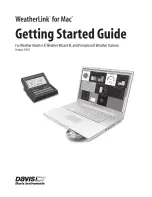
TABLE DATA ADDENDUM
AD-2
AD2 Overview of Data Storage Tables
Within a data table, data is organized in records and fields. Each row in a
table represents a record and each column represents a field. To
understand the concept of tables it may be helpful to consider an example.
A CR10-TD is to be used to monitor 3 thermocouples (TC). Each hour a
temperature for each of the three TC is to be stored. The table has 4 fields
: "DATE_TIME TEMP1 TEMP2 TEMP3". Each hour a new "record"
would be added. The "hourly" table would then be organized as follows:
DATE_TIME TEMP1 TEMP2 TEMP3
01/27/91 10:00:0023.5
24.6
28.2
01/27/91 11:00:0024.2
22.4
23.4
Only the hourly data is stored in the hourly table, Each output interval
has its own table. Data tables can also be "event driven" rather than
interval driven, that is a new record is stored when a specified event
occurs rather than based on time. Each table is completely independent
of any other tables and all records in a given table have the same
number of fields.
The TD operating system supports naming of tables and fields, so any
data value can be referenced by the table and field names. For example,
the temperature data for the first thermocouple is referenced as
"HOURLY.TEMP1". Computer software also allows the station to be
named. When multiple dataloggers are in use, this can be used to
reference specific data in the network. If, in the previous example, the
CR10T site was named DALLAS, the first thermocouple's data values
would be referenced by "DALLAS.HOURLY.TEMP1".
AD3 Converting an existing program to Table Based OS
This section is intended for those familiar with programming an Array
based datalogger.
AD3.1 Programming changes
•
Remove all Record Real Time instructions (Instruction 77).
•
Remove all Serial Data Output and Serial Print instructions
(Instructions 96 and 98).
•
Remove all Initiate Telecommunication (callback) instructions
(Instruction 97).
•
Check all instructions which set the Output Flag (Flag 0). These
should be replaced with the Data Table Instruction (Instruction 84).
If the Set Active Storage Area instruction (Instruction 80) is used, it
should be removed as Instruction 84 provides this functionality.
•
Check all If Time Instructions (Instruction 92) as the units may
change from minutes to seconds. Any instruction 92 that sets the
output flag (Flag 0) is replaced by Instruction 84.
•
Check the Move Time To Input Location Instruction (Instruction
18) as some parameters have changed.
Содержание CR510
Страница 1: ...CR510 DATALOGGER OPERATOR S MANUAL REVISION 2 03 COPYRIGHT c 1986 2003 CAMPBELL SCIENTIFIC INC ...
Страница 2: ...This is a blank page ...
Страница 4: ...This is a blank page ...
Страница 10: ...This is a blank page ...
Страница 44: ...SECTION 1 FUNCTIONAL MODES 1 14 This is a blank page ...
Страница 56: ...SECTION 3 INSTRUCTION SET BASICS 3 8 ...
Страница 104: ...SECTION 8 PROCESSING AND PROGRAM CONTROL EXAMPLES 8 8 This is a blank page ...
Страница 128: ...SECTION 10 PROCESSING INSTRUCTIONS 10 8 This is a blank page ...
Страница 144: ...SECTION 12 PROGRAM CONTROL INSTRUCTIONS 12 10 This is a blank page ...
Страница 172: ...SECTION 14 INSTALLATION AND MAINTENANCE 14 10 This is a blank page ...
Страница 176: ...APPENDIX A GLOSSARY A 4 This is a blank page ...
Страница 184: ...This is a blank page ...
Страница 188: ...APPENDIX D DATALOGGER INITIATED COMMUNICATIONS D 4 This is a blank page ...
Страница 196: ...APPENDIX F MODBUS ON THE CR10 X AND CR510 F 4 This is a blank page ...
Страница 197: ...APPENDIX G TD OPERATING SYSTEM ADDENDUM FOR CR510 CR10X AND CR23X MANUALS ...
Страница 198: ...This is a blank page ...
Страница 200: ...This is a blank page ...
Страница 206: ...TABLE DATA ADDENDUM AD 6 This is a blank page ...
Страница 222: ...TD ADDENDUM SECTION 1 FUNCTIONAL MODES AD 1 8 This is a blank page ...
Страница 238: ...TD ADDENDUM SECTION 8 PROCESSING AND PROGRAM CONTROL EXAMPLES AD 8 10 This is a blank page ...
Страница 240: ...This is a blank page ...
















































